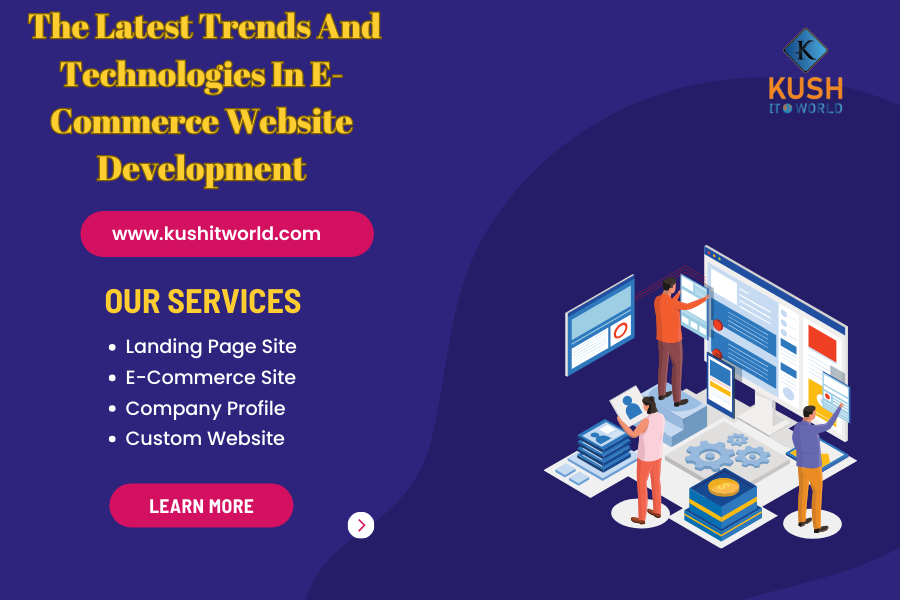E-commerce Development Trends: Explore the latest trends and technologies in e-commerce website development, including payment gateways, product recommendations, and checkout optimizations.
The world of e-commerce is continuously evolving, and staying ahead of the curve is essential for businesses looking to succeed in the competitive online marketplace. As technology advances and consumer preferences shift, e-commerce website development must adapt to meet changing needs. In this article, we will explore the latest trends and technologies in e-commerce website development, including advancements in payment gateways, product recommendations, and checkout optimizations.
1. Advanced Payment Gateways
Payment gateways are the backbone of e-commerce, enabling secure and convenient online transactions. Recent developments in payment gateways have made the payment process smoother, faster, and more secure.
Digital Wallets: Integrating digital wallets like Apple Pay, Google Pay, and Samsung Pay offers users a convenient and secure way to make purchases, reducing cart abandonment rates.
Cryptocurrency Payments: Accepting cryptocurrencies like Bitcoin and Ethereum can open up new markets and cater to tech-savvy customers interested in digital assets.
One-Click Checkout: Simplify the checkout process with one-click checkout options, reducing the number of steps required to complete a purchase.
2. Personalized Product Recommendations
One-size-fits-all approaches to product recommendations are a thing of the past. Today’s consumers expect personalized shopping experiences. E-commerce websites are leveraging advanced technologies to provide tailored product recommendations.
Machine Learning Algorithms: Machine learning algorithms analyze user behavior and preferences to make accurate product recommendations. These algorithms continuously learn and adapt to deliver the most relevant suggestions.
AI-Powered Chatbots: Chatbots can assist users in finding products and make recommendations based on individual preferences. These chatbots offer real-time interactions and enhance the shopping experience.
Personalized Email Marketing: E-commerce websites are utilizing customer data to send personalized email recommendations, leading to higher engagement and conversion rates.
3. Augmented Reality (AR) and Virtual Reality (VR)
AR and VR technologies are making inroads into e-commerce, transforming how consumers interact with products online.
Virtual Try-On: In the fashion and beauty industry, virtual try-on solutions allow users to “try on” clothing, accessories, and makeup virtually, enhancing confidence in their purchase decisions.
360-Degree Product Views: Providing interactive 360-degree product views allows customers to examine products from all angles, improving their understanding of the product’s details.
Virtual Showrooms: VR-enabled virtual showrooms offer immersive shopping experiences, allowing customers to explore and interact with products in a virtual environment.
4. Progressive Web Apps (PWAs)
Progressive Web Apps are hybrid web applications that combine the best of web and mobile apps. They offer fast loading times, offline accessibility, and enhanced user experiences.
Improved Performance: PWAs load quickly and efficiently, reducing bounce rates and improving user engagement.
Offline Access: Users can access PWAs even when they have no internet connection, making them valuable in regions with unreliable connectivity.
Push Notifications: PWAs can send push notifications to users, re-engaging them and promoting new products or offers.
5. Voice Commerce
Voice commerce, also known as v-commerce, is on the rise. With the proliferation of voice-activated devices like Amazon Echo and Google Home, e-commerce websites are adapting to voice search and shopping.
Voice Search Optimization: E-commerce websites are optimizing their content and product descriptions for voice search to ensure that products are discoverable through voice queries.
Voice-Assisted Shopping: Users can add items to their shopping carts, place orders, and track deliveries using voice commands, simplifying the shopping experience.
6. Checkout Optimizations
The checkout process is a critical area for e-commerce website improvement. Reducing cart abandonment rates and streamlining the checkout process is a top priority.
Guest Checkout: Offering guest checkout options reduces friction for first-time shoppers who may be hesitant to create an account.
Multiple Payment Options: Providing a variety of payment options, including credit cards, digital wallets, and Buy Now, Pay Later solutions, caters to diverse customer preferences.
Abandoned Cart Recovery: Implementing abandoned cart recovery strategies, such as sending reminder emails or offering discounts, can win back potential customers.
Conclusion
As the e-commerce landscape continues to evolve, businesses must adapt to meet the ever-changing needs and preferences of online shoppers. Embracing these e-commerce development trends and technologies can provide a competitive edge, enhance user experiences, and drive growth in the digital marketplace. By staying up-to-date with the latest advancements, businesses can create successful and future-proof e-commerce websites that cater to the demands of today’s tech-savvy consumers.











